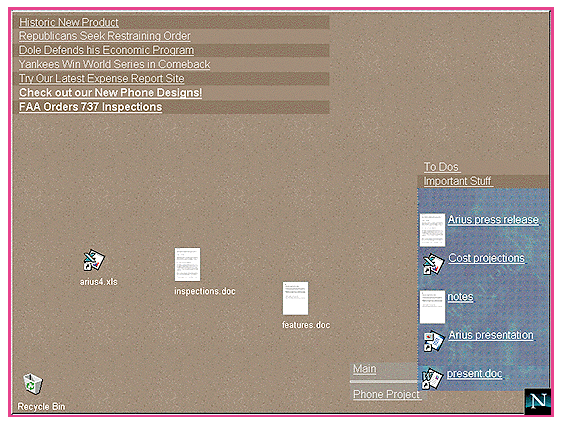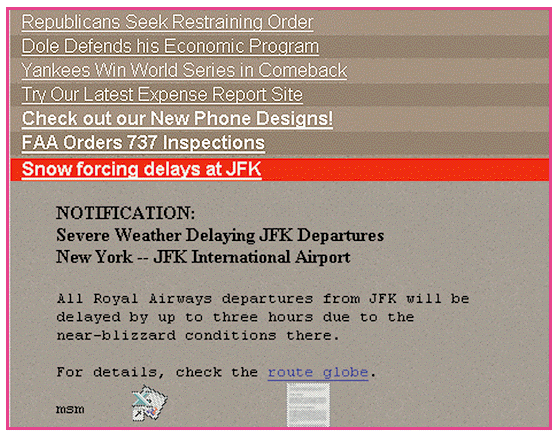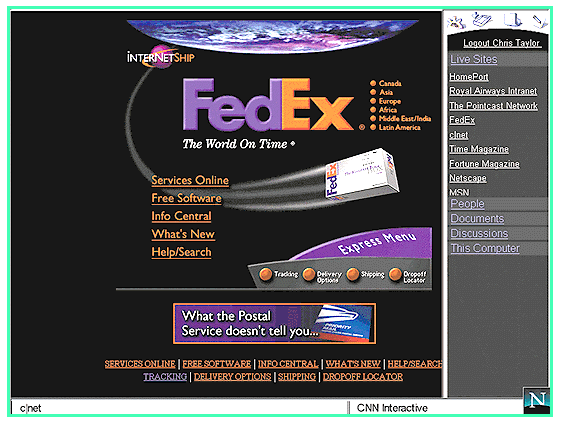| "Where do you want to go today?" asks Microsoft. "Not where you're taking us," says Netscape. Microsoft and Netscape both want to change how users interact with their computers in a wired world. But each company wants to steer those changes in a different direction. Whoever prevails will probably determine the face of computing for the next decade. Both companies are preparing for an age of ubiquitous networking in which users enjoy fast access to immense resources on LANs, WANs, and the Internet. They share some common goals: Give users a seamless view of local and remote resources; take advantage of the latest Web technologies that automatically deliver filtered information to masses of users; and build a cross-platform user interface based on Hypertext Markup Language (HTML) that unifies the experience of network-centric computing. Microsoft's Active Platform — manifested on a PC as Active Desktop — leverages the market dominance of Windows by blending the user interfaces of Windows and the Web. Users can browse their systems as if the local disks were a Web site or explore Web sites as if they were local disks. Internet Explorer 3.0 already allows this to some extent, but much more is coming in Explorer 4.0 and Windows 97. Because Active Desktop relies on dynamic HTML, JavaScript, and VBScript, it will eventually run on other platforms, including Macintoshes and Unix systems. However, Active Desktop will always run better on Windows, Microsoft says, because it is more tightly integrated with Windows, and it can call upon the services of Microsoft's DirectX multimedia APIs and a wider variety of ActiveX controls. An Open Answer Netscape's Constellation takes a less Windows-centric approach and puts more emphasis on location-independent computing, regardless of the platform. No matter what kind of system you're using or where you are, Constellation presents a universal desktop called the Homeport. Although the Homeport can appear in a browser window, Netscape usually demonstrates it as a full-screen layer that buries the native OS — certainly one reason Microsoft is not embracing Constellation. Constellation will work on about 18 different OSes because it's created entirely with HTML, JavaScript, and Java. Netscape envisions the Homeport as the new base for launching local or remote applications and for accessing the network. It's location-independent because Constellation can save the Homeport's state (including all data files created or modified during a session) on a server. The server (running Netscape's SuiteSpot 3.0) can be anywhere on an intranet or the Internet. When you log on, the server restores your Homeport and lets you pick up working where you left off. When you're done, Constellation lets you save copies of your files on the local machine, encrypt the copies, or securely erase all local traces of your session. Add-ons such as Norton Desktop for Windows and At Ease for the Mac have offered replacement desktops for years. But they don't offer location independence across multiple platforms: You can't start a session on a Windows PC at the office and finish it at home on a Mac. Constellation is designed to eliminate the file-synchronization and compatibility problems that bedevil mobile users today. Network Centricity Of course, to really make this work, the applications should be as cross-platform and as network-centric as Constellation. Users can launch native applications such as Microsoft Office from the Homeport, but only if the local system contains those applications. That's why Netscape is a strong supporter of Java. Java programs can arrive over the network and run anywhere. Another key piece of Constellation is convenient access to up-to-date information on far-flung networks. Today, Web browsers let users "pull" information from the Internet on demand, while list servers automatically "push" information into subscribers' mailboxes. Constellation takes advantage of the latest Web technology to supplement those methods with something called "smart pull": the timely delivery of selected information directly to the user's desktop. Users get only the information they asked for, without tedious browsing. And Constellation can notify users as soon as the information is available. These infostreams may contain anything from a stock quote or a sports score to a company memo. Constellation can receive infostreams through Hypertext Transfer Protocol (HTTP), Simple Mail Transfer Protocol (SMTP), Marimba Castanet, and the PointCast Network. HTTP and SMTP are the more conventional methods. They allow senders to encrypt the data within Secure Sockets Layer (SSL) or Secure Multipurpose Internet Mail Extension (S/MIME). A special tag tells Constellation to route the infostream directly to the Homeport, where JavaScript displays it as an HTML pagelet or as an "infoblock" that pops up from the bottom of the screen. Castanet is designed to broadcast selected information to large numbers of people by using Marimba's Transmitter and Repeater servers. Transmitter is the server software that sends information to users who have requested the information by "tuning in" with Marimba's client software, known as Tuner. (Constellation includes a custom version of Tuner.) Repeaters are mirrored Transmitters that permit large-scale broadcasts without bogging down the Web. PointCast is a more established Webcasting network that also delivers filtered information. PointCast can host the content of smaller providers who don't have their own servers, Netscape says. Active Desktop will let users smart-pull information from various sources, too; it remains to be seen which environment works better. But aside from implementation details, the main differences between Active Desktop and Constellation originate from Microsoft's and Netscape's different views of the future. Will Windows Dominate? Microsoft sees Windows as the dominant platform on all types of devices for years to come, so Windows compatibility is paramount. Other platforms need to interoperate with Windows and with Windows technologies such as ActiveX, but Windows running on a PC will continue to be the most common computing experience, and Microsoft will fight to preserve that experience. In contrast, Netscape sees more platform fragmentation. Users will access networks from Windows PCs, of course, but also from Macs, Unix systems, network computers, home videogame consoles, Web appliances, and mobile devices of every stripe. They won't all run Windows. Netscape also expects more users to borrow time on computers they don't own; for example, business travelers might answer e-mail on network computers in airports and hotels. The growing ability to tap into global data networks from almost anywhere on almost any kind of device is the driving force behind Constellation. It explains why Netscape views the network, rather than any particular breed of client, as the center of the new universe. A Universal Home Smart Personalized Information of requested information directly to the desktop. Out of Sight then slide out from various sides of the screen. Home Is Where the Browser Is it's really a full-screen browser window. Tom R. Halfhill (thalfhill@bix.com) is a BYTE senior editor based in the San Mateo, California, bureau. Copyright 1994-1998 BYTE |